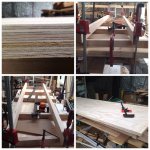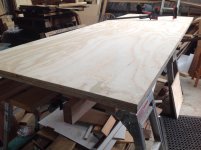Stephen B
Member
- Joined
- May 6, 2013
- Messages
- 2,749
[size=14pt]
I wish to join two 17mm thick ply sheets to make one 34mm for a bench top in the Untidy Shop. My immediate thought is using contact adhesive, coat both contact surfaces, wait 20 mins join and clamp, or should I use the wet method of coat one surface and immediately join and clamp?
Or are there other alternatives in glue/techniques?
With thanks.
[size=10pt]Edit I know I could just purchase thicker ply, but I have plenty of 17mm as they are heavily discounted where I work PTime.
I wish to join two 17mm thick ply sheets to make one 34mm for a bench top in the Untidy Shop. My immediate thought is using contact adhesive, coat both contact surfaces, wait 20 mins join and clamp, or should I use the wet method of coat one surface and immediately join and clamp?
Or are there other alternatives in glue/techniques?
With thanks.
[size=10pt]Edit I know I could just purchase thicker ply, but I have plenty of 17mm as they are heavily discounted where I work PTime.


